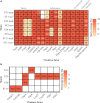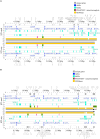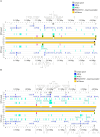Comparative genome analyses of clinical and non-clinical Clostridioides difficile strains
- PMID: 38993487
- PMCID: PMC11238072
- DOI: 10.3389/fmicb.2024.1404491
Comparative genome analyses of clinical and non-clinical Clostridioides difficile strains
Abstract
The pathogenic bacterium Clostridioides difficile is a worldwide health burden with increasing morbidity, mortality and antibiotic resistances. Therefore, extensive research efforts are made to unravel its virulence and dissemination. One crucial aspect for C. difficile is its mobilome, which for instance allows the spread of antibiotic resistance genes (ARG) or influence strain virulence. As a nosocomial pathogen, the majority of strains analyzed originated from clinical environments and infected individuals. Nevertheless, C. difficile can also be present in human intestines without disease development or occur in diverse environmental habitats such as puddle water and soil, from which several strains could already be isolated. We therefore performed comprehensive genome comparisons of closely related clinical and non-clinical strains to identify the effects of the clinical background. Analyses included the prediction of virulence factors, ARGs, mobile genetic elements (MGEs), and detailed examinations of the pan genome. Clinical-related trends were thereby observed. While no significant differences were identified in fundamental C. difficile virulence factors, the clinical strains carried more ARGs and MGEs, and possessed a larger accessory genome. Detailed inspection of accessory genes revealed higher abundance of genes with unknown function, transcription-associated, or recombination-related activity. Accessory genes of these functions were already highlighted in other studies in association with higher strain virulence. This specific trend might allow the strains to react more efficiently on changing environmental conditions in the human host such as emerging stress factors, and potentially increase strain survival, colonization, and strain virulence. These findings indicated an adaptation of the strains to the clinical environment. Further, implementation of the analysis results in pairwise genome comparisons revealed that the majority of these accessory genes were encoded on predicted MGEs, shedding further light on the mobile genome of C. difficile. We therefore encourage the inclusion of non-clinical strains in comparative analyses.
Keywords: Clostridioide difficile; clinical; genome comparison; mobile genetic element; non-clinical; virulence.
Copyright © 2024 Schüler, Riedel, Overmann, Daniel and Poehlein.
Conflict of interest statement
The authors declare that the research was conducted in the absence of any commercial or financial relationships that could be construed as a potential conflict of interest.
Figures








Similar articles
-
Pathogenicity Locus, Core Genome, and Accessory Gene Contributions to Clostridium difficile Virulence.mBio. 2017 Aug 8;8(4):e00885-17. doi: 10.1128/mBio.00885-17. mBio. 2017. PMID: 28790208 Free PMC article.
-
High Prevalence and Genetic Diversity of Large phiCD211 (phiCDIF1296T)-Like Prophages in Clostridioides difficile.Appl Environ Microbiol. 2018 Jan 17;84(3):e02164-17. doi: 10.1128/AEM.02164-17. Print 2018 Feb 1. Appl Environ Microbiol. 2018. PMID: 29150513 Free PMC article.
-
Genomic surveillance of Clostridioides difficile transmission and virulence in a healthcare setting.mBio. 2024 Mar 13;15(3):e0330023. doi: 10.1128/mbio.03300-23. Epub 2024 Feb 8. mBio. 2024. PMID: 38329369 Free PMC article.
-
Clostridioides difficile as a Potential Pathogen of Importance to One Health: A Review.Foodborne Pathog Dis. 2022 Dec;19(12):806-816. doi: 10.1089/fpd.2022.0037. Foodborne Pathog Dis. 2022. PMID: 36516404 Review.
-
Variations in virulence and molecular biology among emerging strains of Clostridium difficile.Microbiol Mol Biol Rev. 2013 Dec;77(4):567-81. doi: 10.1128/MMBR.00017-13. Microbiol Mol Biol Rev. 2013. PMID: 24296572 Free PMC article. Review.
Cited by
-
Global insights into the genome dynamics of Clostridioides difficile associated with antimicrobial resistance, virulence, and genomic adaptations among clonal lineages.Front Cell Infect Microbiol. 2025 Jan 15;14:1493225. doi: 10.3389/fcimb.2024.1493225. eCollection 2024. Front Cell Infect Microbiol. 2025. PMID: 39882343 Free PMC article.
References
-
- Alcock B. P., Huynh W., Chalil R., Smith K. W., Raphenya A. R., Wlodarski M. A., et al. (2023). CARD 2023: expanded curation, support for machine learning, and resistome prediction at the comprehensive antibiotic resistance database. Nucleic Acids Res. 51, D690–D699. doi: 10.1093/nar/gkac920, PMID: - DOI - PMC - PubMed
-
- Alkudmani Z. S. B. (2018). The identification and characterization of novel haemolysin genes from Clostridium difficile: University College London.
LinkOut - more resources
Full Text Sources
Molecular Biology Databases
Research Materials

